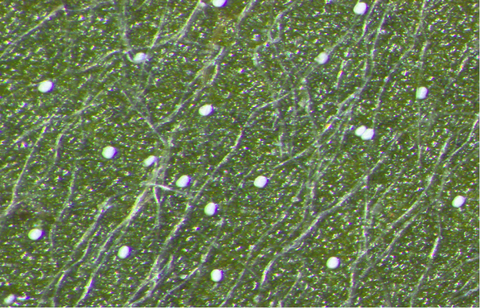Chinese Mugwort, Artemisia verlotiorum Lamotte, is known in Belgium since 1937 when it was found on rough ground in Brussels (Matagne 1938). It remained very rare and poorly known for quite a long time but it is obviously increasing in recent times (Verloove 2003). Artemisia verlotiorum, like our native A. vulgaris L., belongs with Artemisia section Artemisia (“the Artemisia vulgaris-complex”), a large group of closely related and still insufficiently understood species with many representatives in the Asian Far East.
In the past decades several additional weedy species from this complex have been reported in Eastern Europe. For Ukraine, Mosyakin (1990) cited (in addition to the American Artemisia ludoviciana Nutt.) A. selengensis Turcz. ex Besser, A. rubripes Nakai, A. umbrosa Turcz. ex DC. and A. argyi Léveillé & Vaniot. More recently, Sîrbu & Oprea (2011) found three Far Eastern species on a single railway yard in Romania: Artemisia argyi, A. lancea Vaniot and A. lavandulaefolia DC. (the latter corresponding doubtlessly with Ukrainian A. umbrosa).
These results prompted the author to critically review aberrant populations of Artemisia verlotiorum and even A. vulgaris in Belgium and the Netherlands. At least three additional species were recognized recently: Artemisia argyi, A. cf. princeps and A. selengensis. Our studies will be continued in 2013 and a lengthy paper published in time in Dumortiera. In this short account these “new” species are depicted and some additional information provided (including a provisional identification key). Botanists are encouraged to critically review Artemisia in their neighborhood!
Artemisia argyi Léveillé & Vaniot
Native in: China, Korea, Mongolia, Russia [alien in: the Netherlands, Japan, Ukraine, Romania]
Known since 2005 from an unloading quay in the Waalhaven in the port area of Rotterdam (discovered by Remko Andeweg)
Differs from A. verlotiorum in being more densely hairy (upper leaf surface and involucre are persistently hairy), slightly larger flower heads, presence of numerous white sessile glands on upper leaf surface, phenology (earlier flowering), erect inflorescence branches (not recurved-arcuate), etc.
 |
 |
 |
Artemisia princeps Pampanini
Native in: China, Japan, Korea [alien in: Belgium]
Discovered by the author in 2011 on rough ground in the port of Antwerp (E of Churchilldok). Given its abundance (nearly monospecific stand of ca. 2500 m²!) probably present since some time or very fast colonizing.
Much reminiscent of Artemisia vulgaris but flowering later (from end of August onwards), stoloniferous (and hence ultimately forming large stands), large inflorescence with divaricate branches, narrower heads only ca. 1.5 mm across, etc.
 |
 |
 |
 |
 |
Artemisia selengensis Turcz. ex Besser
Native in: China, Korea, Mongolia, Russia [adventive in: Ukraine, Baltic States, the Netherlands]
Discovered in 2012 on the verge of a Phragmites stand in Volkeraksluizen (near Willemstad) by Marc van Soest, Petra van der Wiel and others.
Differs from both A. verlotiorum and A. vulgaris by leaf segments with small acute regular teeth, its strong odour, typical inflorescence with several erect, tightly appressed branches, glabrous upper foliage and stems, etc.
 |
 |
 |
 |
A provisional identification key for the Belgian and Dutch representatives of the Artemisia vulgaris-complex currently known is presented here:
1 Plant without long rhizomes, rarely with short rhizomes, not stoloniferous (growing solitary or in small groups). Leaves with distinct petiolar pectinations (pseudo-stipules), never glandular punctate. Plant not aromatic. Flowering from July onwards === Artemisia vulgaris
Plants always with long rhizomes and stoloniferous, finally always growing in large colonies. Not flowering before end of August === 2
2 Leaf segments finely, acutely and regularly serrulate along margins. Stem and upper leafside (nearly) glabrous, very aromatic but not glandular punctate. Inflorescence of several long, narrow erect panicles. Petiolar pectinations mostly lacking === A. selengensis
Leaf segments with entire margins or with a few large and irregular teeth. Stem at least slightly pubescent === 3
3 Leaves without glands, petiolar pectinations distinct. Inflorescence a wide panicle with branches diverging at 50 ° or more. Heads ca. 1.5 mm wide, sparsely arachnoid. Plant not aromatic === A. princeps
Leaves glandular punctate (but only visible on leaf upper side), white glands numerous or sparse. Inflorescence a narrowly pyramidal panicle without diverging branches. Heads 2.5-4 mm wide, arachnoid to glabrescent === 4
4 Upper leaf side glabrescent, sparsely glandular punctate. Heads glabrescent. Petiolar pectinations present. Inflorescence with primary lateral branches distinctly arcuate. Plant aromatic === A. verlotiorum
Upper leaf side persistently hairy, densely glandular punctate. Heads persistently arachnoid hairy. Petiolar pectinations absent or poorly developed. Inflorescence branches erect, not arcuate. Plant not aromatic === A. argyi
The author is much indebted to Dr. Koji Yonekura (Japan) and Dr. Anna Boiko (Ukraine) for the identification of Artemisia argyi and A. princeps.
References
Matagne H. (1938) Quelques phanérogames nouvelles pour la flore belge. Bull. Soc. Roy. Bot. Belg. 61: 68-72.
Mosyakin S.L. (1990) New and noteworthy alien species of Artemisia L. (Asteraceae) in the Ukrainian SSR. Ukr. Botan. Zhurn. 47(4): 10-13.
Sîrbu C. & Oprea A. (2011) New records in the alien flora of Romania (Artemisia argyi, A. lavandulaefolia) and Europe (A. lancea). Turk. Journ. Bot. 35: 717-728. [available online at: http://journals.tubitak.gov.tr/botany/issues/bot-11-35-6/bot-35-6-10-1007-4.pdf]
Verloove F. (2003) Artemisia verlotiorum in Vlaanderen: recent uitbreidend of lang over het hoofd gezien? Dumortiera 81: 76-81.
Filip Verloove
March 2013


Add new comment